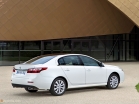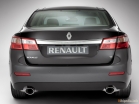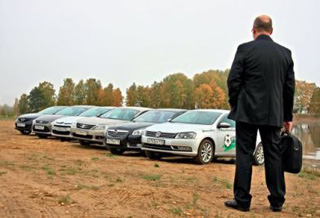technical characteristics of Renault Latitude since 2010 sedan
Technical characteristics of Renault Latitude 2010, 2011, 2012, 2013: power, fuel consumption per 100 km, weight (mass), road clearance (clearance), turning radius, type of transmission and brakes, body size and tires
Engine characteristics
| Modifications |
Engine volume, cm3 |
Power, kW (lp)/about |
Cylinders |
Twisting, Nm/(rpm) |
Type of the fuel system |
Type of fuel |
| 2.0 CVT |
1997 |
(139)/6000 |
In order - 4 |
(191)/3700 |
Injector |
Petrol |
| 2.5 at |
2495 |
(177)/6000 |
V -shaped - 6 |
(233)/4400 |
Injector |
Petrol |
Drive and transmission
| Modifications |
type of drive |
Type of transmission (basic) |
Type of transmission (optionally) |
| 2.0 CVT |
Front-wheel drive |
Variable speed drive |
|
| 2.5 at |
Front-wheel drive |
6-ACPP |
|
Suspension type and turning radius
| Modifications |
Front suspension |
Rear suspension |
The diameter of the turn, m |
| 2.0 CVT |
Independent - Mcpherson |
Independent - multi -link |
11.2 |
| 2.5 at |
Independent - Mcpherson |
Independent - multi -link |
11.2 |
Brake system and steering wheel amplifier
| Modifications |
Type of front brakes |
Type of rear brakes |
Power steering |
| 2.0 CVT |
Disk ventilated |
Disk |
- |
| 2.5 at |
Disk ventilated |
Disk |
- |
The size of the tires
| Modifications |
The size |
| 2.0 CVT |
Front wheels: 215/55 R16, rear wheels: 215/55 R16 |
| 2.5 at |
Front wheels: 215/60 R16, rear wheels: 215/60 R16 |
Dimensions
| Modifications |
Length, mm |
Width, mm |
Height, mm |
The track front/back, mm |
Wheel base, mm |
Road clearance (clearance), mm |
Trunk volume, l |
| 2.0 CVT |
4887 |
1832 |
1483 |
-/- |
2762 |
127 |
477/- |
| 2.5 at |
4887 |
1832 |
1483 |
-/- |
2762 |
127 |
477/- |
Car weight
| Modifications |
Equipped mass, kg |
Maximum mass, kg |
Lifting capacity, kg |
| 2.0 CVT |
1495 |
2050 |
555 |
| 2.5 at |
1600 |
2110 |
510 |
Number of seats and doors
| Modifications |
The number of seats |
Number of doors |
| 2.0 CVT |
5 |
4 |
| 2.5 at |
5 |
4 |
The volume of the fuel tank
| Modifications |
Tank volume, l |
Type of fuel |
| 2.0 CVT |
70 |
AI-95 |
| 2.5 at |
70 |
AI-95 |
Dynamics
| Modifications |
Maximum speed, km/h |
Acceleration time to 100 km/h, with |
CD (frontal resistance coefficient) |
| 2.0 CVT |
186 |
11.9 |
- |
| 2.5 at |
209 |
10.7 |
- |
Fuel consumption
| Modifications |
In the city, l/100 km |
On the highway, l/100 km |
Average consumption, l/100 km |
Extrication CO2, g/km |
Type of fuel |
| 2.0 CVT |
11 |
7 |
8.3 |
- |
Petrol |
| 2.5 at |
13.4 |
7.7 |
9.7 |
- |
Petrol |
Renault Latitude prices since 2010 in Russia (updated on April 22, 2016)
| Modifications in G.V. |
Total cars on sale (in the Russian Federation) |
Average price,
rubles |
Average price s
Automatic transmission, rubles |
Total on sale with automatic transmission |
Average price s
Manual transmission, rubles |
Total on sale with manual transmission |
| 2010 |
22 |
900 258 |
904 380 |
22 |
574 671 |
6 |
| 2 l |
10 |
864 419 |
864 419 |
10 |
- |
6 |
| 2.0 l |
6 |
824 376 |
824 376 |
6 |
- |
6 |
| 2.5 l |
9 |
983 617 |
983 617 |
9 |
- |
6 |
| 2011 |
25 |
952 168 |
953 591 |
25 |
- |
6 |
| 2 l |
9 |
915 813 |
915 813 |
9 |
- |
6 |
| 2.0 l |
7 |
843 001 |
843 001 |
7 |
- |
6 |
| 2.5 l |
9 |
1 068 395 |
1 068 395 |
9 |
- |
6 |
| 2012 |
22 |
1 219 035 |
1 215 590 |
21 |
1 336 098 |
6 |
| 2 l |
8 |
1 000 623 |
1 000 623 |
8 |
- |
6 |
| 2.0 l |
6 |
889 315 |
889 315 |
6 |
- |
6 |
| 2.5 l |
10 |
1 358 571 |
1 351 238 |
10 |
1 658 838 |
6 |
| 2013 |
57 |
1 399 244 |
1 401 181 |
57 |
1 280 724 |
7 |
| 2 l |
22 |
1 287 512 |
1 288 920 |
22 |
1 252 376 |
6 |
| 2.0 l |
7 |
1 266 705 |
1 266 705 |
7 |
- |
6 |
| 2.5 l |
25 |
1 563 694 |
1 563 694 |
25 |
- |
6 |
Video test drives Renault Latitude since 2010
Configuration Renault Latitude since 2010
Test drives
From dirt to City
The heroes of this test are united by what they desperately want to break with their predecessors. Renault Vel Satis and Peugeot 407 with a bang lost a market struggle, and Kia Magentis was known as the favorite of the proletarians, not white collarbone. Will Renault Latitude, Peugeot 508 and Kia Optima will succeed from getting out of dirt to City? Peugeot 508 glorious ...
Office plankton. 6 business class sedanov
Karelia. In Karelia, great! And that is why we organize our own, already the third in a row, it is on it. But if at the first time we risked to meddle there on crossovers, then this time we decided to visit this beautiful corner of our Motherland, we decided it easier on cars on the sedans of the business class, Testamazda 6 ...
The color of "sofas"
Skilling science is small in cars. Although no great automobile journalist, of course, is recognized in this. All these elusively subtle matters of the differences between, say, crossover and SUV were invented with one purpose to hang the marketing noodles on the ears of ordinary mortals as much as possible. In fact, there is a much more understandable approach ...









